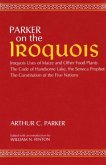This is the first major book to explore uniquely Haudenosaunee (Iroquois), and specifically Oneida, components in the Native American oral narrative as it existed around 1900. Even as Anthony Wonderley studies time-honored themes and such stories as the Haudenosaunee account of creation, he breaks new ground examining links between legend, history, and everyday life. Wonderley examines how oral traditions are born and develop. Uncovering tales told over the course of 400 years, Wonderley further defines and considers endurance and sequence in oral narratives and explores possible links between Oneida folklore and material culture. Arguably the most complete study of its kind, the book will appeal to a wide range of professional disciplines from anthropology, history, and folklore to religion and Native American studies.
Hinweis: Dieser Artikel kann nur an eine deutsche Lieferadresse ausgeliefert werden.
Hinweis: Dieser Artikel kann nur an eine deutsche Lieferadresse ausgeliefert werden.






![Hochelagans and Mohawks [microform]: a Link in Iroquois History Hochelagans and Mohawks [microform]: a Link in Iroquois History](https://bilder.buecher.de/produkte/65/65604/65604948m.jpg)

